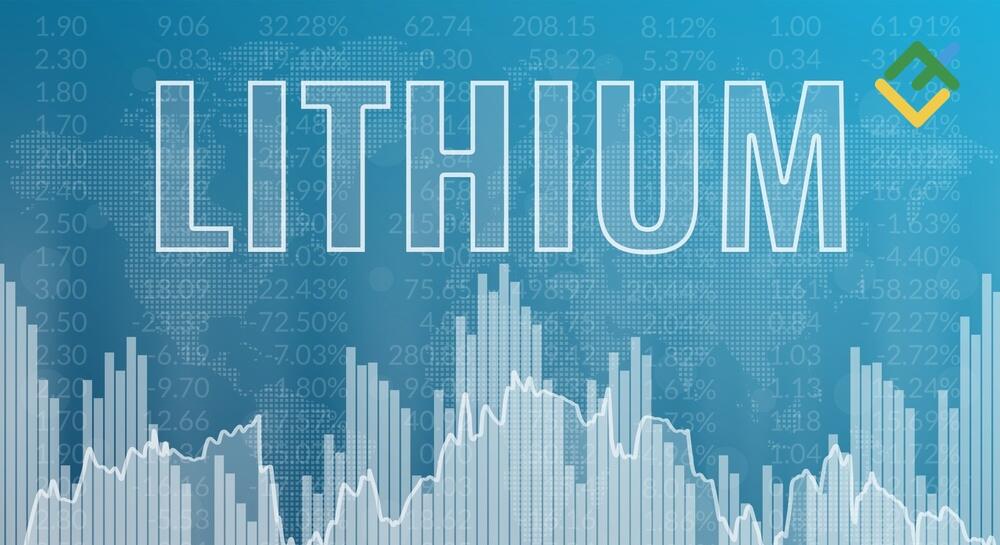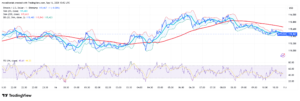Best Lithium Stocks to Buy in 2025: Top Mining Companies Investment Guide

Lithium stocks skyrocketed in 2021 as prices for the metal and its derivatives went through the roof. This increase was fueled by surging demand for electric vehicles (EVs) and the green-energy boom, amplified by generous government subsidies. Since then, the euphoria has cooled. EV demand has lost momentum, subsidies have been withdrawn, and lithium prices have collapsed by more than 80–90% over the year. Yet many analysts argue the era of electric vehicles and battery-driven technologies is still in its infancy. It means that now is the time to buy lithium stocks at rock-bottom prices.
This overview introduces you to the lithium market outlook and the best lithium stocks to invest in right now.
The article covers the following subjects:
Major Takeaways
- Lithium and its compounds, primarily lithium carbonate and lithium hydroxide, are essential inputs for battery manufacturing. Additionally, this commodity is utilized in glass and ceramics production, lubricating greases, medicine, and electronics.
- Lithium stocks spiked in 2021–2022, driven by growing demand for electric vehicles and government support. Then, after lithium prices dropped, most stocks declined.
- Lithium production is largely concentrated in Chile, Argentina, and Australia. China also influences the supply/demand ratio in the lithium products market.
- Lithium stocks are long-term investments, with a long-term outlook tied to the energy transition. Shifting away from oil and gas as energy sources will propel demand for lithium products. Therefore, analysts predict that lithium stocks will reach record highs in the next five years.
Why Lithium Stocks Can Be Appealing to Investors in 2025
The automotive sector drives most of the demand for lithium and its derivatives. About 54% of global consumption goes into lithium-ion batteries for electric vehicles and electronic devices such as laptops and smartphones. Glass and ceramics account for 19% of usage, lubricating greases for 12%, and pharmaceuticals for about 7%.
The surge in demand for electric vehicles in 2021 boosted lithium prices and lithium mining and processing stocks. Subsequently, a correction occurred as consumers were not prepared to abandon oil and gas products. The high cost of EV maintenance, limited driving range, underdeveloped long-distance charging infrastructure, and lengthy charging times all played a major role.
Analysts are confident that the shift towards electric vehicles is inevitable, especially as oil and gas reserves continue to dwindle and environmental issues remain unresolved. As a result, shares in lithium mining stocks may skyrocket again, offering potential returns of over 100% and providing an attractive long-term investment opportunity.
Best Lithium Stocks to Buy Now
Lithium stocks can be divided into three categories:
- Lithium mining stocks. Companies that are directly involved in lithium extraction.
- Lithium refining stocks. Companies that process lithium resources, such as ore and metal, into lithium carbonate and hydroxide. These compounds are essential feedstocks for producing batteries, glass, and ceramics.
- Manufacturing stocks. Companies that produce end products for consumers from lithium processing products.
Below are some of the best lithium stocks to buy that fall into one or more of these categories. While many lithium stocks have declined since lithium prices slumped in 2022, they still offer upside potential as the next wave of demand for lithium resources builds.
SQM (Sociedad Química y Minera de Chile)
Country: Chile.
Exchange: Santiago Stock Exchange, NYSE.
5-Year Return: +33.73%, 1-Year Return: +20.46% (as of 10.08.2025).
SQM is a Chilean chemical company that produces fertilizers, iodine, lithium, and industrial chemicals. It is one of the world’s largest lithium producers, with vertically integrated operations from brine extraction to battery-grade salts. In 2024, SQM signed a partnership agreement with the state-owned company Codelco to operate in the Atacama Desert from 2025 to 2060.
Its customers include leading battery makers in Asia, Europe, and the US. For example, SQM has a long-term agreement to supply battery-grade lithium carbonate and lithium hydroxide to LG Energy Solution that runs through 2029. Unlike many lithium stocks, SQM’s share price did not plunge alongside the drop in lithium prices, thanks to its diversified business model.
Albemarle Corporation (ALB)
Country: USA.
Exchange: NYSE.
5-Year Return: -18.30%, 1-Year Return: -0.68% (as of 10.08.2025).
Albemarle is a global specialty chemicals corporation operating across three core areas: lithium mining and production of lithium compounds, bromine and bromine-based products, and refining catalysts for the oil industry. The company’s operations span Australia, the US, and Chile.
Pilbara Minerals (PLS)
Country: Australia.
Exchange: ASX.
5-Year Return: +484.85%, 1-Year Return: -35.23% (as of 10.08.2025).
Pilbara Minerals is an Australian mining company focused on lithium extraction from spodumene and tantalum. Its primary asset is the Pilgangura deposit in Western Australia, a major source of hard rock lithium deposits, which has been under development since 2018. The company also owns the Colina deposit in Brazil. It collaborates with Ganfeng Lithium, General Lithium, POSCO, Yibin Tianyi, and other metal processing companies.
Rio Tinto (RIO)
Country: Australia, UK.
Exchange: ASX.
5-Year Return: +12.13%, 1-Year Return: -1.10% (as of 10.08.2025).
Rio Tinto is an international mining company headquartered in Melbourne and London. It is the third-largest mining company in the world in terms of market capitalization. The company explores, mines, and processes minerals, including lithium, iron ore, aluminium, copper, and diamonds. In 2025, Rio Tinto acquired one of the largest lithium mining companies, Arcadium Lithium, turning it into its Rio Tinto Lithium division.
The company operates in the Australian, Argentine, and US markets. Its main suppliers are automotive companies, and notably, it has secured a long-term agreement with Ford to provide lithium and low-carbon materials.
Ganfeng Lithium Group (002460)
Country: China.
Exchange: Shenzhen Stock Exchange and Hong Kong Stock Exchange.
5-Year Return: +3.69%, 1-Year Return: +52.18% (as of 10.08.2025).
Ganfeng Lithium Group is a vertically integrated Chinese company engaged in lithium extraction, processing, and production, along with lithium battery manufacturing. It is China’s largest lithium compounds producer and among the world’s leading players in lithium products and metal output. The company has mining operations in Argentina, Mali, and Australia.
Get access to a demo account on an easy-to-use Forex platform without registration
Go to Demo Account
Best Lithium ETFs for Diversified Investment
Lithium-focused ETFs (exchange-traded funds) offer a simple way to invest without having to pick different types of stocks on your own. These portfolios are built and rebalanced by professional managers, with commissions typically below 1%. Returns are driven by diversification. Some funds, such as BATG, CHRG, ACDC, and Amplify Lithium & Battery Technology ETF (BATT), span the entire battery value chain, from raw materials and components to battery manufacturers. Others may also include mining companies from outside the lithium sector.
L&G Battery Value-Chain UCITS ETF (BATG, LSE)
The L&G Battery Value-Chain UCITS ETF has delivered an annual return of +31.42% in GBP. The fund primarily invests in end-user companies of the lithium supply chain, with holdings across Japan, Germany, South Korea, and Australia. The top 10 of its 38 holdings account for 35% of the portfolio and include companies such as HD Hyundai Electric, Siemens Energy, and Sumitomo Electric Industries, Ltd. The portfolio is broadly diversified, with no single holding exceeding 4%.
Global X Lithium & Battery Tech UCITS ETF (LITU, LSE)
The Global X Lithium & Battery Tech ETF has been one of the strongest performers in recent years. In 2024, it returned +21.7%, ranking among the best results even as most lithium mining stocks declined. The fund holds 36 securities spanning the entire lithium value chain. Its top 10 positions account for 47.5% of the portfolio, led by Albemarle Corporation (8.26%) and Sociedad Química y Minera de Chile (5.39%). The third-largest holding, Tesla (4.87%), helps balance the volatility of the major mining stocks.
Global X Battery Tech & Lithium ETF (ACDC, ASX)
The Global X Battery Tech & Lithium ETF is one of the few funds that has stayed profitable over the past five years, with a modest dip in performance only in 2022. Its 1-year return stands at +10.5%. The fund holds 38 assets and focuses on downstream companies, such as Delta Electronics, Hyundai Electric, and Siemens Energy.
Best Lithium Stocks Performance Analysis
The profitability of lithium stocks fell sharply after 2023 due to a slump in lithium prices, triggered by a falling demand for the metal. Consequently, some stocks dropped by more than 30–50%.
So far, there are no signs that demand will recover to 2022 levels. Lithium stocks periodically jump in response to news about supply cuts, such as the temporary shutdown of a major Chinese mine. However, analysts warn that the rally is outpacing fundamentals, so a correction is possible. The market remains highly volatile, depending on the policies of China, the US, and producing countries.
How to Choose the Best Lithium Stocks to Invest In
In order to select the best stocks, analyze the supply and demand ratio in the lithium and EV markets, review stock analysis and stock valuation, and monitor the financial performance and multiples of each company. Some investors also take into account dividend yield when assessing overall attractiveness.
Lithium stocks with diversified businesses can appeal to short-term investors, as they tend to show high volatility in the near term but offer longer-term stability thanks to fundamentals in other segments. By contrast, shares of pure-play lithium producers are better suited for long-term investment, since the global shift toward alternative energy will ultimately drive sustained growth in lithium demand.
Key Investment Factors to Consider
The key criteria for assessing short- and long-term prospects of lithium stocks can be divided into two groups: general and individual. The first group includes factors that affect the entire market. If the market stagnates, most company stocks will also depreciate.
General Factors:
- Demand for lithium from various industries. The demand is driven primarily by the electric vehicle market and the battery technology sector. A key indicator is the trend in EV demand, measured by quarterly and annual sales and by production figures from major automakers such as Tesla and BYD.
- Government support programs. Partial subsidies for EV buyers, tax breaks for the auto industry, and greater funding signal continued policy tailwinds.
- Lithium mining and derivative production volumes. Monitor quarterly data from the top 10 mining and processing companies, such as those in Australia, Chile, and China.
- Substitution risks. If cheaper, safer, and more accessible energy storage alternatives emerge, explosive growth in lithium stocks is unlikely.
Individual Factors:
- Financial statements and multiples. The results should align with forecasts and industry averages. Valuation multiples help assess whether shares are undervalued and track changes in a company’s financial health.
- Lithium producers’ business diversification. Narrow specialization can be a disadvantage. Companies engaged in the extraction of multiple metals and resources are generally more attractive, as a downturn in the lithium market can be offset by growth in other segments, such as tantalum. Another factor is vertical integration: firms with a full production cycle, from resource extraction to finished products, have a better chance of remaining stable.
- Changes in companies’ production capacity. Growth drivers include joint ventures to develop new deposits, participation in new projects, and reductions in the cost of lithium extraction and processing.
These factors are critical for short-, medium-, and long-term investments. If you want to find the most profitable lithium stocks with promising returns, evaluate all indicators, taking into account risk management rules. Besides, diversify your investment portfolio. For example, add shares of semiconductor companies and blue chips.
Investment Strategies for Best Performing Stocks
Potential lithium investment options:
- Short-term stock trading based on volatility. Technical analysis strategies with trades held open for 1–5 days. Returns on particular shares can range from 3–5% to 7%.
- Long-term investing in lithium stocks. This strategy relies on expectations that government subsidies for the EV industry will resume and that rising lithium demand will push shares to new all-time highs.
- Investing in diversified ETFs of lithium battery manufacturers and lithium producers. The funds are supervised by professional managers. The diversified portfolio will help smooth out volatility.
Another strategy for investing in lithium is short-term trading based on fundamental factors. This approach is suitable for savvy investors who have a strong grasp of the lithium and lithium products market and stay in tune with the latest news. The idea is to spot news that signals a surge in demand for lithium products, at least at the local level.
For example, take the US company QuantumScape, founded in 2010. It has a relatively narrow focus: developing solid-state lithium-metal EV batteries. Following strong Q2 2025 results and a deal to supply lithium to PowerCo, Volkswagen's battery subsidiary, its shares nearly doubled in a month.
Lithium Market Analysis 2025: Supply and Demand
In 2018–2019, lithium traded at about $12,000–$15,000 per metric ton. By mid-2022, prices had surged past $60,000, with spot levels at times exceeding $100,000 per metric ton.
After a rapid rally in 2022, the market began to decline. By early August 2025, lithium prices had fallen by more than 85%, dropping below $10,000.
According to experts, the decrease is caused by weaker demand for the metal amid growing supply, in particular, a slowdown in electric vehicle sales and rising output of lithium and lithium products from Chinese companies.
Global Supply Outlook
The lithium market is expected to remain in a modest surplus in 2025, at around 33,000 tons of LCE (Lithium Carbonate Equivalent), driven by increased supply from Australia and Argentina. However, this may prove temporary. In early August, CATL suspended lithium production in Jiangxi after its license expired, while the Chinese government moved to curb oversupply in the raw materials market. The shutdown cut global production by about 3%, and shares in lithium producers rose sharply: Tianqi Lithium Corp. gained 19% and Ganfeng Lithium Group Co. climbed 21%.
In 2026–2027, new production capacity is anticipated to come online, while demand is expected to remain fairly stable. This will likely put pressure on lithium prices and stocks. By 2030, burgeoning battery demand may cause a renewed lithium shortage. Unless new production capacity is added quickly, a structural deficit may emerge, which in turn would drive lithium stocks higher.
Lithium Demand Growth Drivers
Key factors driving global lithium prices:
- Growing demand for EVs equipped with lithium-ion batteries and, consequently, a decrease in their price/maintenance costs. Demand for EVs remains relatively low, as they are more expensive and less convenient to operate than petrol or diesel vehicles.
- Government subsidies and support programmes for EVs and clean energy sources. State support can help partially cover end-user costs and sustain demand for electric transport.
- Expansion of ESS (Energy Storage Systems) for the integration of renewable sources and ensuring grid reliability.
- Increasing demand for consumer electronics (smartphones, laptops, tablets) that use lithium batteries.
- Decline in lithium production, for example, due to logistics issues and gradual depletion of deposits.
- Recycling and secondary use of spent lithium batteries from electric vehicles. Advancements in this field may reduce companies’ demand for lithium, lowering their costs and increasing net profits.
- Diversifying the use of lithium in other industries, including glass manufacturing, ceramics, lubricating grease production, medicine, and pharmaceuticals.
Analysts remain cautious about a major rebound in lithium prices, with reports from the International Energy Agency also signaling that supply may continue to outpace demand in the near term. Geopolitical tensions and trade wars do not favor demand for electric vehicles and battery technology. With the metal hovering at $9,000–$10,000 a ton, it is unlikely that the price will climb above $20,000 in the next 1–2 years.
Risks of Investing
Risks of investing in lithium stocks:
- Price volatility. The last five years have shown that the metal value can increase several times and fall by 90% in a year. The main volatility drivers are fluctuations in industrial demand for lithium and changes in production volumes.
- The advent of alternative battery technologies will lead to the replacement of lithium, a decline in demand for the metal, and, accordingly, a fall in lithium stocks.
- Environmental risks. Lithium mining and lithium product manufacturing pose significant environmental hazards. Tighter regulatory restrictions may lead to higher production costs and increased expenses for lithium stocks.
- Risk of overproduction. New players entering the market and expansion of production capacity may trigger a structural supply surplus.
- Individual risks. Technological disasters in production, litigation, and corporate conflicts.
Conclusion
Lithium stocks are high-risk assets that may only take off a few years from now. The advantage of purchasing lithium stocks today is that, after the slump in 2023–2024, many of the stocks are trading near rock-bottom levels, making this an attractive entry point.
Optimistic scenario: In 2-3 years, the US and China will cease their trade wars, and tensions involving Taiwan, Russia, and India will ease. The world’s leading economies will return to the idea of developing and promoting clean energy solutions. As a result, lithium stocks will experience a remarkable growth of over 100%.
Pessimistic scenario: Demand for electric vehicles will remain unchanged, and volatility will persist over the next 2-3 years, devoid of any prospects for stable profits.
Realistic scenario: Alternative energy sources and lithium-ion batteries for energy storage will become increasingly popular. However, the transition to these sources will be slow and gradual.
The content of this article reflects the author’s opinion and does not necessarily reflect the official position of LiteFinance broker. The material published on this page is provided for informational purposes only and should not be considered as the provision of investment advice for the purposes of Directive 2014/65/EU.
According to copyright law, this article is considered intellectual property, which includes a prohibition on copying and distributing it without consent.







